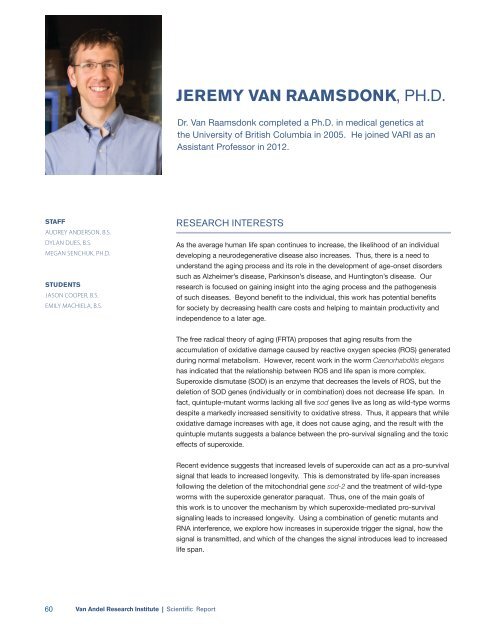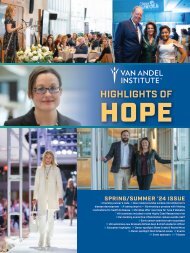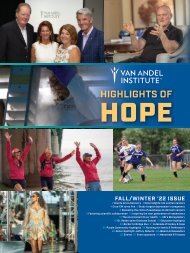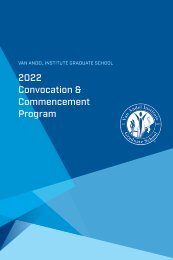2016 Scientific Report
Create successful ePaper yourself
Turn your PDF publications into a flip-book with our unique Google optimized e-Paper software.
JEREMY VAN RAAMSDONK, PH.D.<br />
Dr. Van Raamsdonk completed a Ph.D. in medical genetics at<br />
the University of British Columbia in 2005. He joined VARI as an<br />
Assistant Professor in 2012.<br />
STAFF<br />
AUDREY ANDERSON, B.S.<br />
DYLAN DUES, B.S.<br />
MEGAN SENCHUK, PH.D.<br />
STUDENTS<br />
JASON COOPER, B.S.<br />
EMILY MACHIELA, B.S.<br />
RESEARCH INTERESTS<br />
As the average human life span continues to increase, the likelihood of an individual<br />
developing a neurodegenerative disease also increases. Thus, there is a need to<br />
understand the aging process and its role in the development of age-onset disorders<br />
such as Alzheimer’s disease, Parkinson’s disease, and Huntington’s disease. Our<br />
research is focused on gaining insight into the aging process and the pathogenesis<br />
of such diseases. Beyond benefit to the individual, this work has potential benefits<br />
for society by decreasing health care costs and helping to maintain productivity and<br />
independence to a later age.<br />
The free radical theory of aging (FRTA) proposes that aging results from the<br />
accumulation of oxidative damage caused by reactive oxygen species (ROS) generated<br />
during normal metabolism. However, recent work in the worm Caenorhabditis elegans<br />
has indicated that the relationship between ROS and life span is more complex.<br />
Superoxide dismutase (SOD) is an enzyme that decreases the levels of ROS, but the<br />
deletion of SOD genes (individually or in combination) does not decrease life span. In<br />
fact, quintuple-mutant worms lacking all five sod genes live as long as wild-type worms<br />
despite a markedly increased sensitivity to oxidative stress. Thus, it appears that while<br />
oxidative damage increases with age, it does not cause aging, and the result with the<br />
quintuple mutants suggests a balance between the pro-survival signaling and the toxic<br />
effects of superoxide.<br />
Recent evidence suggests that increased levels of superoxide can act as a pro-survival<br />
signal that leads to increased longevity. This is demonstrated by life-span increases<br />
following the deletion of the mitochondrial gene sod-2 and the treatment of wild-type<br />
worms with the superoxide generator paraquat. Thus, one of the main goals of<br />
this work is to uncover the mechanism by which superoxide-mediated pro-survival<br />
signaling leads to increased longevity. Using a combination of genetic mutants and<br />
RNA interference, we explore how increases in superoxide trigger the signal, how the<br />
signal is transmitted, and which of the changes the signal introduces lead to increased<br />
life span.<br />
60 Van Andel Research Institute | <strong>Scientific</strong> <strong>Report</strong>

















